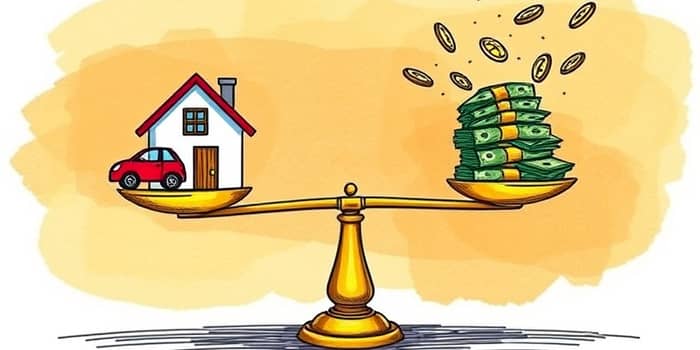Understanding the variety of loan options available can feel daunting, but with clear information and practical examples, borrowers can make confident financial decisions. This guide dives deep into the world of personal, secured, and unsecured loans, providing definitions, comparisons, and actionable tips.
Whether you need funds for a major purchase or are shopping for the best interest rate, this article will equip you with the knowledge to choose the right loan for your situation and help you navigate the approval process with ease.
Definitions and Basic Concepts
A personal loan is essentially money borrowed from a lender that is repaid with interest in regular installments over a defined term. These loans can be either secured—backed by an asset—or unsecured, relying solely on the borrower’s creditworthiness.
In contrast, a secured loan requires collateral which reduces lender risk. Common forms of collateral include real estate, vehicles, savings accounts, and investment portfolios. If you default on the loan, the lender may seize the pledged asset to recover losses.
An unsecured loan involves no asset at risk. Approval hinges on credit score, income, and debt-to-income ratio. Because lenders assume more risk, these loans often carry higher interest rates for unsecured loans and stricter eligibility criteria.
Key Differences Between Secured and Unsecured Loans
Choosing between secured and unsecured loans depends on your financial profile, the amount you need, and your willingness to use collateral. The table below highlights the most important contrasts.
Types and Examples
Loans can serve various purposes, and understanding specific examples will help you select the product best suited to your needs. Here are the main categories:
Secured loans tend to offer lower rates and higher amounts because collateral provides security for the lender. Examples include:
- Mortgages (home as collateral)
- Auto loans (vehicle as collateral)
- Home equity loans and HELOCs (equity in property)
- Secured credit cards (cash deposit held)
On the other hand, unsecured loans provide flexibility and quick access, though often at a premium rate:
- Personal loans or signature loans
- Credit cards
- Student loans
- Unsecured lines of credit
How Loans Work
At their core, loans involve three key components: the principal, the interest rate, and the repayment term. When you agree to borrow, you receive a lump sum or a credit line that must be paid back over a specified period.
The interest rate reflects the lender’s assessment of risk. Secured loans typically feature lower rates because the collateral mitigates potential losses. Unsecured loans carry higher rates to compensate lenders for the increased risk.
Repayment options vary. Term loans require fixed or variable monthly installments that amortize the balance over several years. Revolving credit, such as credit cards or HELOCs, allows you to borrow repeatedly up to your credit limit as long as you make minimum payments on time.
Pros and Cons
Both secured and unsecured loans bring unique advantages and drawbacks. Understanding these trade-offs ensures you select the solution that aligns with your goals and risk tolerance.
Secured Loans
Pros:
- Lower rates and higher borrowing limits make these loans suitable for major purchases like homes and vehicles.
- Approval is often easier for borrowers with limited credit history, since the asset provides collateral.
Cons:
- You face the risk of losing collateral upon default, which can be financially devastating.
- Funds may be tied to specific uses, such as property improvements or vehicle purchase.
Unsecured Loans
Pros:
- No asset at stake means no asset at risk if you encounter repayment difficulties.
- Application processes are typically faster, often with minimal documentation required.
Cons:
- Higher interest rates can increase the overall cost of borrowing.
- Borrowing limits are generally lower, and the best rates demand excellent credit.
Eligibility and Approval Criteria
Lenders evaluate several factors before approving your loan application. For secured loans, collateral appraisal and ownership documents are essential, along with standard financial checks.
Unsecured loans hinge more heavily on credit history, income stability, and existing debt levels. Lenders want to ensure you have the capacity to repay without risking an asset.
Here are the five key areas lenders assess when reviewing any loan application:
- Credit history and credit score trends
- Current debt-to-income ratio and cash flow
- Value and type of collateral (if applicable)
- Borrower character, including past repayment behavior
- Comprehensive documentation (tax returns, statements)
Common Use Cases
Different loan types excel in particular scenarios. Matching your funding need to the right product can save money and reduce stress.
Use secured loans for large, long-term purchases:
- Buying or refinancing a home
- Purchasing a vehicle
- Consolidating higher-interest debt when you own real estate
Unsecured loans are ideal for shorter-term needs and flexible spending:
- Funding home renovations or medical expenses
- Consolidating credit card debt without risking your house
- Covering wedding or vacation costs
Tips and Considerations
Before signing on the dotted line, keep these practical tips in mind:
- Shop around and compare APRs, origination fees, and prepayment penalties.
- Read the fine print on collateral requirements and usage restrictions.
- Maintain a healthy credit score by making on-time payments and keeping credit utilization low.
- Consider smaller, short-term unsecured loans for quick funding without risking valuable assets.
- For large investments, leverage secured options only if you can comfortably afford collateral risk.
Conclusion
Personal and secured loans each serve distinct purposes, offering trade-offs between cost, speed, and risk. Armed with this comprehensive guide, you can evaluate which option fits your financial goals, whether it’s purchasing a home, consolidating debt, or covering unexpected expenses.
By understanding definitions, key differences, eligibility criteria, and best use cases, you’ll be equipped to choose the loan that balances your borrowing needs with your tolerance for risk and cost.
References
- https://www.bankrate.com/loans/personal-loans/secured-vs-unsecured-personal-loans/
- https://www.firsthope.bank/what-is-a-secured-personal-loan-vs-unsecured/
- https://www.td.com/us/en/personal-banking/learning/unsecured-vs-secured-loan
- https://www.experian.com/blogs/ask-experian/secured-vs-unsecured-loans-what-you-should-know/
- https://www.investopedia.com/terms/l/loan.asp
- https://www.investopedia.com/secured-vs-unsecured-loans-7558592
- https://www.wolterskluwer.com/en/expert-insights/what-banks-look-for-when-reviewing-a-loan-application










